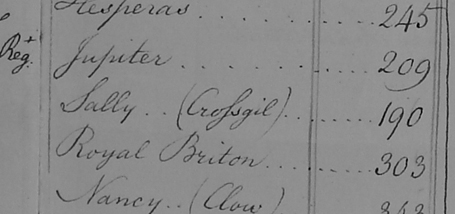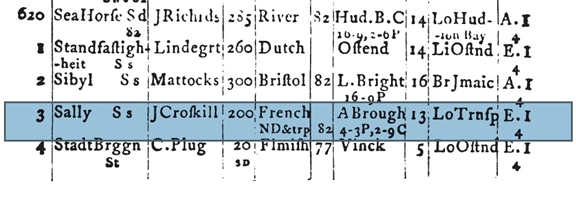
This listing of a 190-ton vessel named Sally, commanded by a Captain Crossgil, was discovered on a document in the British National Archives. This document listed the ships that were to be used by the British Army during the evacuation of Charleston in December 1782.
Ask any maritime archaeologist and they will candidly point out that for every hour spent diving on a shipwreck there is easily another hundred hours required to process the information one has collected. I have been living proof of this since our last major discoveries on the Storm wreck with the regimental buttons and “brown bess” land pattern muskets. If the formulae holds true, then I have spent enough time diving on the site to keep me busy for the next several years.
To date, we believe the Storm site shipwreck to be the remains of a Loyalist refugee ship, part of a fleet evacuating from Charleston during the waning days of our American Revolution. This ship is thought to have wrecked itself upon the sandbar off St. Augustine sometime on New Year’s Eve, 1782. The Royal Provincial and 71st Regiment of Foot uniform buttons we found on the wreck site provided some tantalizing clues to the identity of this ship, and with this year’s findings from the National Archives in England we thought we had a pretty solid case for identification as the Sally. As soon as we made the announcement though, continuing historical research has proven this theory wrong. Such is the way with historical research and archaeology. How did I figure this out? Let me walk you through a little research here and see the results.
One of the most prestigious and thorough shipping insurance companies in the world is Lloyd’s of England. They were, and still are the predominant insurance carriers for English mercantile ships to this day. The record keeping of this company has been impeccable, and if you know where to look there are lists of ships insured by Lloyd’s dating all the way back to 1764. The Lloyds listings contain a very detailed description of the vessels they insured, and I have been able to pour through the archive and identify not just one but nearly all of the ships Sir Guy Carleton mentioned in his original list of transports for the evacuation of Charleston.
Lets start with the most tantalizing of the list: This is Sir Carleton’s listing for a Sally, mastered by a man named Crossgill (see the image above). This ship reported that they had 190 tons of available shipping space for evacuees and their baggage. Lloyd’s has a listing for this ship. At first glance it looks very cryptic, yet once you get the hang of reading the entries the listing provides an amazing description of the ship and its construction.

The annotations in this listing describe the Sally as 200 ton French built ship, with a sheathed bottom, and a draft of 13 ft. The ship underwent thorough repairs in 1782 that included the installment of a new deck. Her captain was A. Brough, and his master was of course J. Crosskill. The juiciest information in this listing is the mention that Sally was armed with four 3-pounder cannon, and two 9-pounder carronades, VERY similar to the armament found on the Storm wreck (so far we have unearthed four 4-pounder cannon and two 9-pounder carronades).
One would think we were on to something here. All the clues start pointing to this being our Sally, and the ship we have been investigating. Unfortunately though, this particular ship is continually insured for the following year and beyond.

This is the same Sally, listed in 1784. You can see that a new Master was hired on, and that the ship was surveyed as in “good repair” that same year. This ship clearly did not meet its demise on the St. Augustine sandbars in December 1782.
This is the same story for all three of the ships named Sally within Sir Carleton’s original list. They are continually insured year after year until each one is eventually sold and undergoes a change in name along with new ownership. If the Storm wreck was one of the ships included in Carleton’s list of transports, it was not a Sally.
Surprisingly I have been able to identify nearly all 114 ships listed in Sir Carleton’s document in Lloyd’s Register of Shipping. Because of this, I can follow each listing year by year, and slowly we are getting a list of suspect ships that were insured in 1782, that are missing in 1783. The search is proving to be quite interesting indeed. To quote a favorite literary hero of mine: “The hunt continues Watson, The game is afoot!”

The 450 ton Desire listed above was slated as an Army transport for the evacuation of Charleston in December 1782, but she is struck out as “Lost” in 1783. Is it possible she was one of the many vessels lost off St. Augustine? Stay tuned…
Guest Blog by Brian McNamara, LAMP Archaeologist

